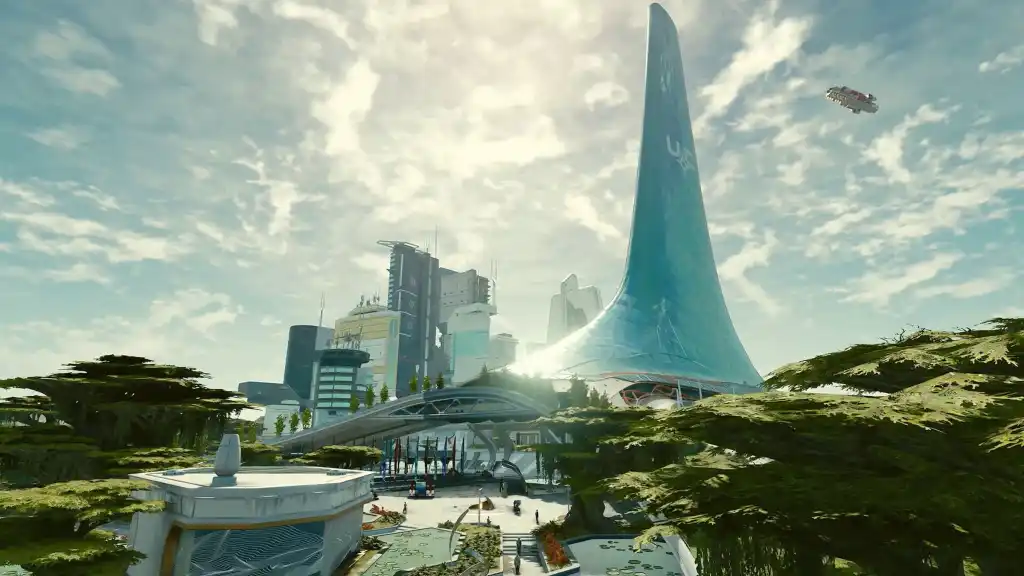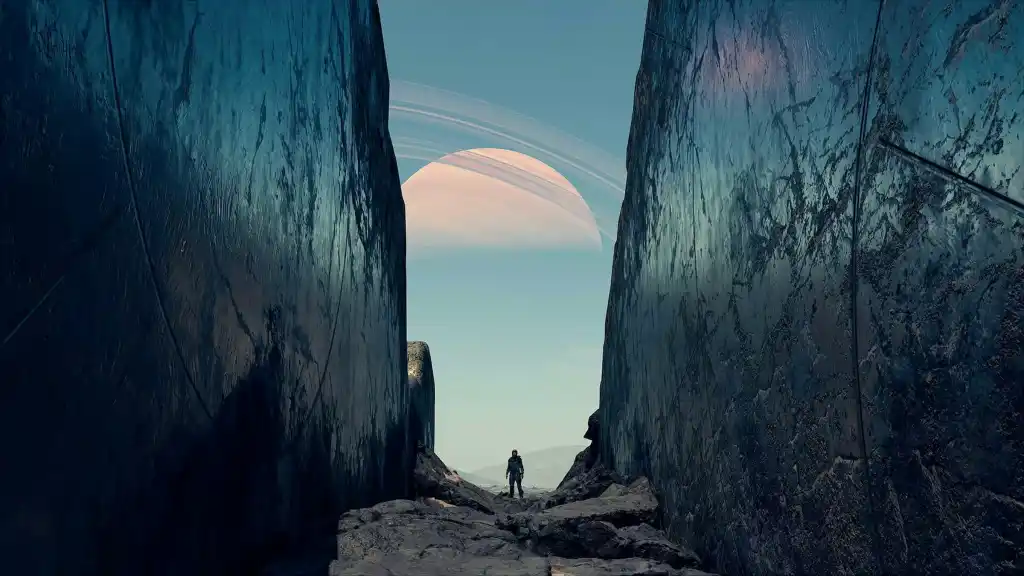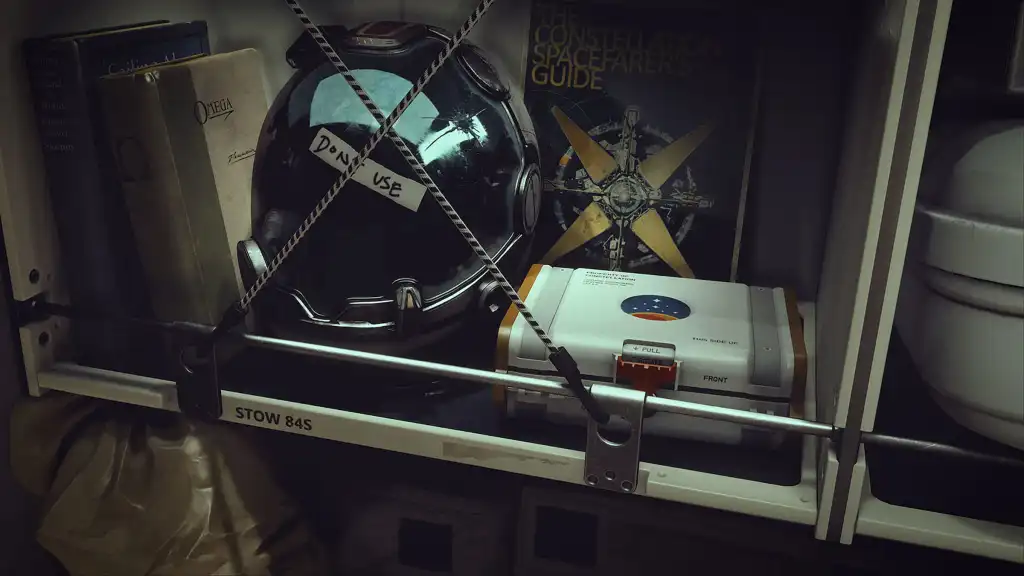When Starfield was first unveiled, it promised to redefine exploration through the lens of human ambition and cosmic wonder. We were meant to lose ourselves in a living galaxy, where every log, ruin, and relic told the story of mankind’s ascent to the stars. That dream crumbled quickly. Beneath the surface of its scale and spectacle lies a hollow pattern that any player with more than a few hours will start to see. Every settlement, bunker, and laboratory looks eerily familiar.
Videos by ComicBook.com
And yet, Bethesda didn’t leave that sameness unacknowledged. In fact, they built a lore explanation around it; the so-called “Old War Era.” In theory, this was meant to give meaning to the monotony. Through logs, quest notes, and environmental hints, players learn of a great industrial age of conflict that once spanned the settled systems. Prefabricated buildings and repeated layouts were all products of this war-driven manufacturing boom. It’s an idea that could have been powerful, a historical scar that explains why the galaxy feels so mass-produced at times. But instead of enriching the world, it became an excuse for it. The “Old War Era” was Bethesda’s way of rationalizing repetition with lore so shallow it collapses under its own intent. And the worst part? It’s so painfully obvious.
How the Old War Era Was Meant to Explain Repetition

The “Old War Era” should have been one of Starfield’s most fascinating pieces of lore. A galaxy shaped by an old-age conflict offers endless possibilities for storytelling. You can imagine battlefields turned to dust, ghost stations drifting through orbit, derelict fleets swallowed by space and time. But what we got is a handful of mentions scattered through terminal entries, dialogue snippets, and quest flavor text. It’s not a story, but a smokescreen with malicious narrative intent. Every identical research outpost, every reused mining complex, every bunker carved from the same mold is brushed off as a relic from this supposed wartime era. It’s a narrative bandage, not a narrative thread.
The idea itself could have worked with care. History as design rationale is nothing new for Bethesda. Fallout’s Vault-Tec and The Elder Scrolls’ Dwemer ruins both used repetition to convey societal behavior across numerous games. The difference is that those worlds felt lived in, though. There was no blatant excuse to explain them. Often, they couldn’t be explained at all due to circumstances. But you could feel the desperation in Fallout’s vaults and see the hubris in Dwemer technology. They made sense. Starfield’s Old War Era doesn’t breathe like that. It doesn’t exist in the same spectrum. It doesn’t shape the environment. Instead, it excuses it when convenient. Bethesda hoped that players would accept monotony if it came with a backstory. Unfortunately, they forgot to make it remotely convincing. It really only highlights how empty the explanation is.
What makes this misstep sting even more is that the foundation was promising. A war that industrialized the stars should have echoes in every part of the game’s world: propaganda, survivors, and corporations still profiting from its legacy. While a small amount of that happens, it’s never to a point of being remotely viable to follow. The “Old War Era” exists in text and whispers but never in actual presence, unless you count the endless amount of bunkers present, all with the same layout down to the pencil placement. There’s no sense of loss, nor is there an emotional anchor to make you care. Bethesda failed to develop the concept by using it as a tool to hide a design flaw rather than tell a human story.
Why the Narrative Fails to Mask Procedural Generation

If Bethesda had leaned into the “Old War Era” concept as more than just set dressing, the game’s procedural repetition might have had purpose. A universe built from the remains of mass industrial warfare could have been poetic: a quiet reflection on humanity’s tendency to reuse and rebuild from the ruins of its own conflicts. But the writing never commits to anything strong about it. The references are shallow, the connections thin, and the history too convenient. Every piece of lore feels like it exists to make excuses for the environment being copied and pasted, not to deepen it. The Old War Era is invoked, but hardly explored.
The lore attempts to explain why things look the same, but the more you encounter it, the more it reveals itself as a weak disguise for laziness. Bethesda used the war as a narrative shield, hoping you would fill in the gaps with imagination that the writing itself never provides. It’s almost insulting for those who come to their games expecting narrative integrity. The “Old War Era” could have been a throughline connecting generations of characters, shaping entire economies or religions, influencing the politics of every faction. Instead, it’s mentioned in passing, rarely spoken out loud, leaving a galaxy of empty rooms pretending to have history.
For writers, this approach feels especially painful. What Bethesda did here is like watching a once-great novelist reuse the same paragraph across chapters and calling it symbolism. Instead of feeling the scale of a galaxy, you’re reminded that everything you see is built from the same box of parts. The lore’s job was to breathe life into that design choice, to make it believable. It had to convince that the uniformity was the result of history, not indifference. But the writing never commits to that illusion, and the façade collapses only a few hours into the game. It’s why so many players were so disappointed. You can almost hear the script trying to convince you it’s working when your eyes already know it isn’t. And again, it only takes a few hours of gameplay to realize how pathetic the narrative actually is.
The Consequences of Repetition on Player Experience

Really, the worst part about the “Old War Era” narrative is that it erodes and undermines trust. When players feel that a game is trying to justify its flaws instead of owning them, the illusion of immersion breaks that much faster. Every time a player sees another recycled structure, they’re not thinking about a galaxy shaped by a long-forgotten conflict. They’re thinking about why the developers thought they wouldn’t notice. It’s a subtle insult to curiosity, and it drains the life from exploration faster than any bug or glitch ever could.
This shallow worldbuilding ripples into the overall experience. Exploration loses meaning when history feels fake. Starfield’s environments may have been built by algorithms, but the lore didn’t need to feel the same way. A well-written “Old War Era” could have become the backbone of Starfield’s identity, almost like a haunting reminder of human persistence and decay, much like Fallout’s nuclear wasteland. Instead, it’s an afterthought. It tells nothing new about the world, the people, or the legacy of the war itself. The player walks away not enlightened, but empty, like they’ve been shown a stage set instead of a world.
Starfield tried to weaponize its lore to cover a blatant design weakness, and thought people wouldn’t notice. Insulting. Truly. The “Old War Era” was a missed opportunity to turn repetition into reflection, to make sameness a part of the story’s emotional texture. Instead, it became a hollow apology whispered through terminals that no one remembers. For storytellers, it feels like a betrayal, not because Starfield failed to be perfect, but because it failed to be honest about what it was obviously trying to hide.
What do you think? Leave a comment below and join the conversation now in the ComicBook Forum!









